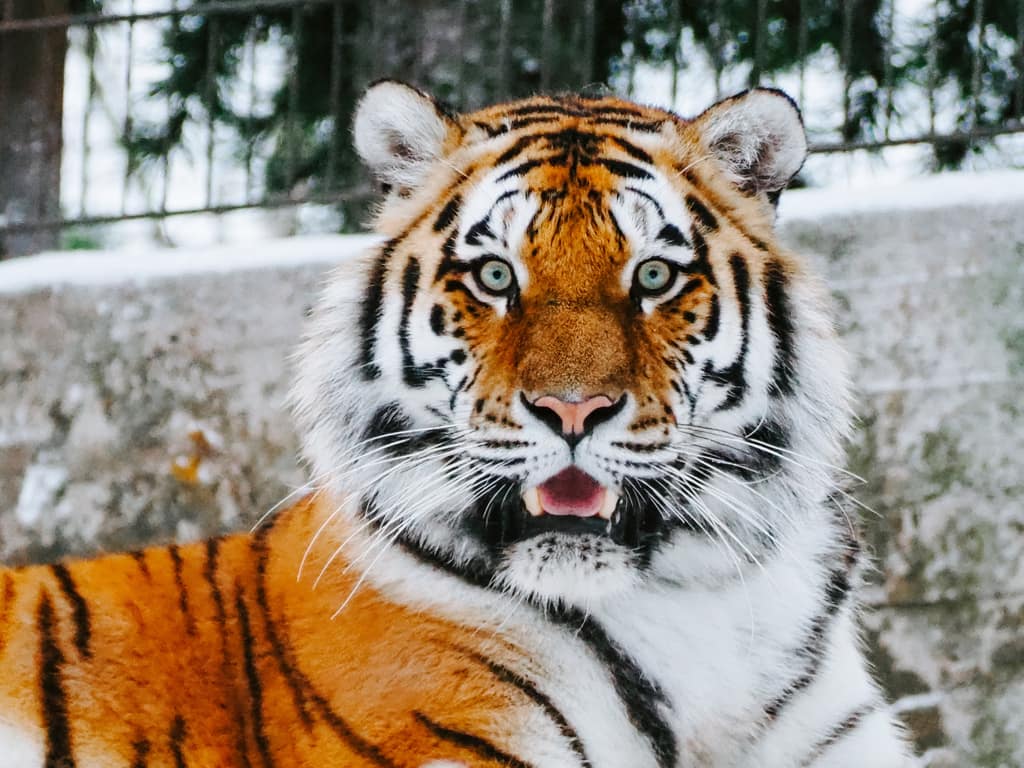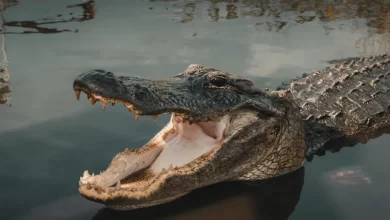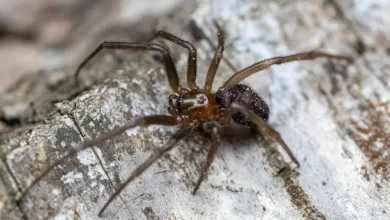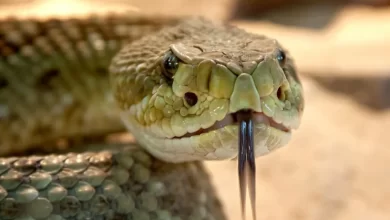Most Jellyfish has a bell-shaped body with long tentacles on the underside. Tentacles are long “arms” that contain stinging cells known as nematocysts. They move by contracting their bodies, but they have little control over where they go: they usually drift with the water current. Let’s check out 66 amazing facts about this marvelous sea creature.
- A jellyfish’s head is called a “bell.” Their mouth is located underneath. They paralyze or stun their prey with their tentacles before eating them.
- Scientists from all over the world have experimented with jellyfish proteins to make other animals glow in the dark. They have experimented on cats, pigs, and even chickens so that they could glow in the dark.
- Thousands of marine creatures, especially turtles, die every year by swallowing plastic bags thinking of as its Jellyfish.
- There is a species of Jellyfish that can be practically immortal. The species is known as Turritopsis dohrnii and is found worldwide in tropic to temperate waters.
- The hydra jellyfish are tiny freshwater organism which is found in most of the oceans. They can grow their body in few days; even it is cut into half.
- Jellyfish are invertebrates species, which means they are animals without a physical skeleton.
- They are made up of 95 percent water. If you take Jellyfish out of the water, it will become a fascinating blob and die.
- The creature doesn’t have lungs, hearts, or even a brain. Still, they live without these important organs
- Their skin is so thick that oxygen is absorbed through it, and there is no blood in them, so they don’t need a heart for pumping.
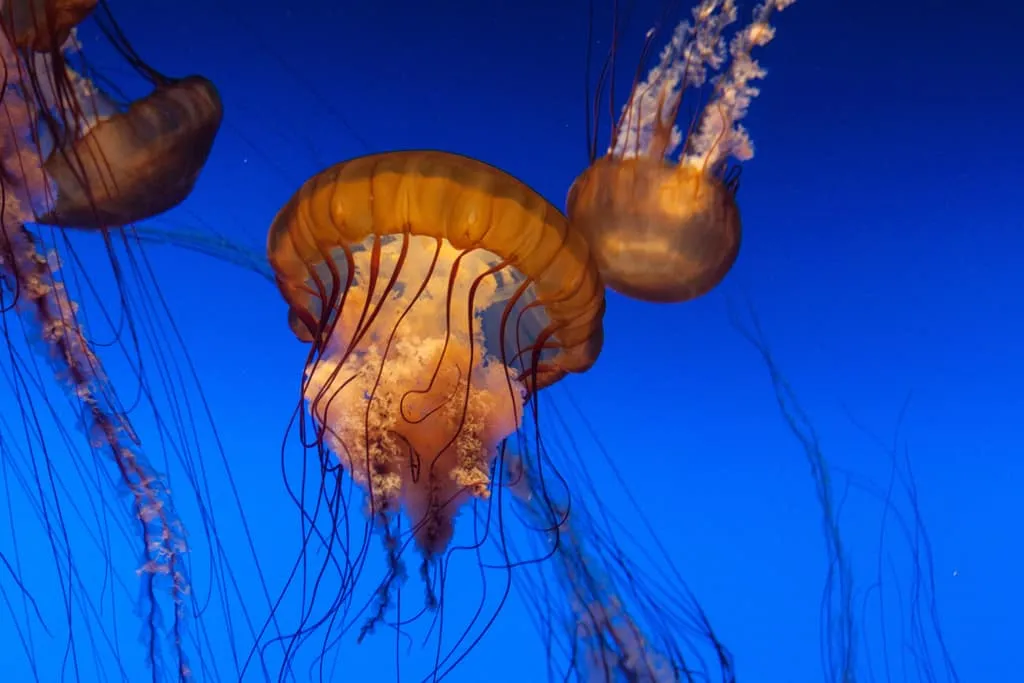
- A Jellyfish group is often called ‘swarm,’ ‘bloom,’ or ‘smack.’
- The most giant Jellyfish ever recorded was a lion’s mane jellyfish and was found in 1870, which measured 2.3 m across its bell. Its tentacles measured 36.5 m (120 feet) in length. It was even longer than a blue whale.
- Jellyfish are not counted as fish because they aren’t. They are invertebrates or animals without any backbones.
- The primary defense mechanism of a jellyfish is its stings and its transparent body, which make them easy to hide.
- They have a short tube that hangs down from its body. The tube acts as its mouth as well as its digestive tube.
- In some jellyfish, a central tube is surrounded by frilly pieces that look like curly ribbons in the water. These ribbons are called as mouth arms or oral arms.
- Jellyfish are typically seen in shallow coastal waters, but scientists have found that some of the species also live at depths of 9,000 meters (30,000 feet). Whereas most jellyfishes prefer warm waters to live in, and some live at subarctic temperatures.
- Jellyfish contains tentacles that have thousands of killer cells that are called cnidoblast or cnidocyte. These cells are explosive cells used to for defense from predators or to catch prey.
- The tentacles are armed and can sting whether it is separated from Jellyfish’s body.

- The smallest Jellyfish in the world is the creeping Jellyfish. It has bell disks from 0.5 mm to a few mm in diameter. It reproduces asexually by splitting in half.
- Whereas the second contender for the smallest Jellyfish of the world is the highly toxic Australian Irukandji, It is the size of a fingernail.
- According to the statistics from Australian Marine Stinger Advisory Services,there have only been three deaths worldwide in the last 100 years caused due to Irukandji jellyfish. This small Jellyfish can send 50-100 people to the hospital annually.
- Most of the jellyfishes have stingers on their tentacles, but the Irukandji Jellyfish has stingers on their bell piece as well.
- The Lion’s mane jellyfish is the largest true Jellyfish on the planet. They can have tentacles of up to 120 feet (36.6 m) in length. In contrast, its bell can measure up to 7 feet, 6 inches (2.3 m) across. It can be found in the cold waters across the North Atlantic, the Arctic, and Pacific oceans. Its sting is quite painful but not much deadly for human beings.
- Most medium and large-sized Jellyfish survive and feed on small Jellyfish, small fishes, and other small ocean creatures.
- The second-largest jellyfish is the Nomura jellyfish, just after Lion’s mane jellyfish. It can weigh up to 200 kg.
- The giant Jellyfish called Stygiomedusa gigantea has been seen only 115 times in the last 110 years.
- Jellyfish produce both asexually and sexually. They live in deep waters of the seas and are very rarely seen.
- Jellyfish has a lifespan from few hours to many months. One species of Jellyfish is believed to live for about 30 years.
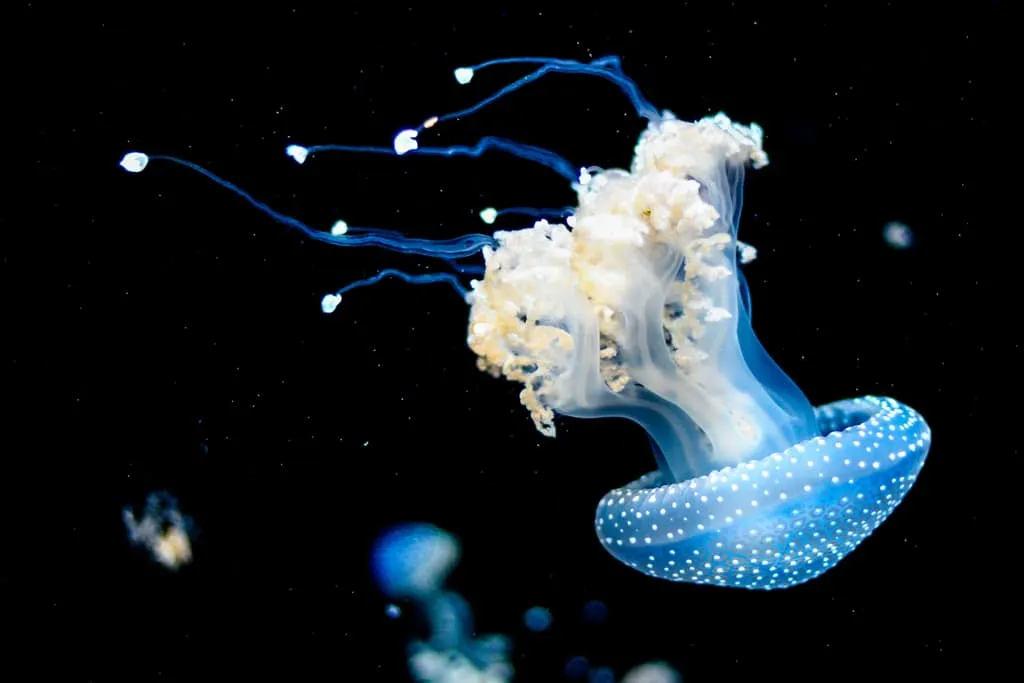
- Their main predators are sharks, swordfishes, Sea turtles, ocean sunfish, penguins, tunas, and one specific species of pacific salmon.
- There are more than 2,000 different kinds of Jellyfish worldwide. Scientists, however, say there may be as many as 300,000 distinct species yet to be identified. For the 2,000 organisms known to humans, only 70 can be harmful.
- There is a species of Jellyfish called turritopsis nutricula, which is also known as immortal Jellyfish. They are called as immortal as they can transform themselves from matura medusa state to polyp state and avoiding death this way. They achieve this through a cell development process known as transdifferentiation.
- The type of Jellyfish most seen on the shores of North America and Europe is the Moon jellyfish.
- These moon jellyfish are typically blue, purple, or pink and are found in waters approximately 20 feet (6 meters) deep. Its sting is usually mild but can leave itchy, red rashes on the skin.
- Even a dead jellyfish can sting and can be poisonous to the human or creatures who got stung.
- Jellyfish have lived and evolved in ocean waters for more than 650 million years; this is long before than dinosaurs and sharks, making them the oldest multi-organ animal on the planet.
- The upside-down Jellyfish doesn’t float in the water. Instead, Rather it anchors itself to the ocean floor, stretching up its tiny arms and tentacles. It seems more like a bowl of plants than a standard medley.
- There are more than two thousand different types of Jellyfish. Out of which approximately seventy can hurt people, with the box jellyfish (Chironex fleckeri) being the most dangerous.
- Scientists believe that there could be as many as three lakh different Jellyfish species yet to be discovered.
- Jellyfishes are not fish in actuality. Their body is made up of a non-living jelly-like substance called mesoglea. They are one of their own kind.
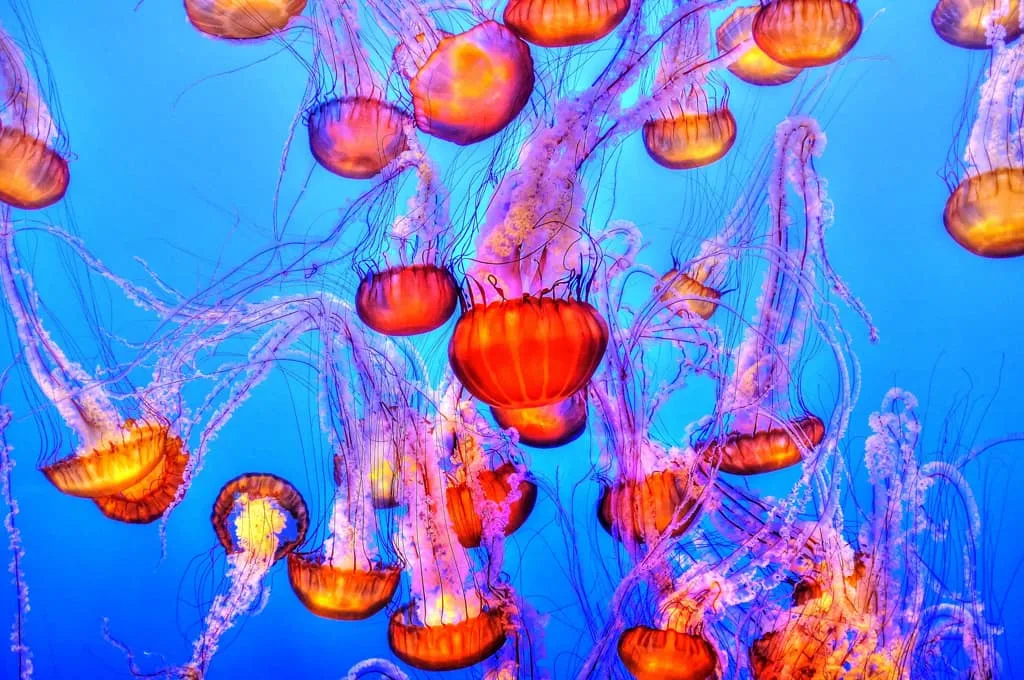
- Essentially, Jellyfish move in two ways. They take water in their bell and then squirt it out behind them, making a stream of water for them to step forward.
- The body of a jellyfish consists of six parts. The inner layer is called as gastrodermis, which lines the gastrovascular cavity. The middle layer is made up of a thick substance called the mesoglea. Whereas the outer layer is the epidermis. It also has an orifice and tentacles.
- Researchers suggest that the shipping industry has artificially distributed Jellyfish into nonnative habitats where they then colonize.
- Ships transport jellyfish around the world in two ways:
i) Juvenile Jellyfish (polyps) attach to ship hulls and travel with them, and
ii) Ships take on ballast water in originating harbors and then dump their ballast water (along with Jellyfish and other organisms) in new waters. Billions of gallons of ballast water are transported annually around the globe. - Jellyfish are aggressive colonizers. Eight years after comb jellyfish were introduced into the Black Sea in 1982, they totalled about 900 million tons. Jellyfish have caused $350 million in losses to the Black Sea’s fishing and tourism industries.
- Jellyfish accounts for more than ten times the weight of the annual catch worldwide. Nearly 150 million people are exposed to Jellyfish across the globe annually. About 200,000 people in Florida and 500,000 across the Chesapeake Bay are stung each year.
- Environmental stress is increasing jellyfish swarms. Jellyfish are one of the very few creatures that can easily adapt to ocean dead zones or zones where there is little oxygen and lots of pollution. There are over 400 marine dead zones in the world.
- In several parts of the world, Jellyfish are considered a delicacy. Approximately several hundred metric tons of Jellyfish in a year are eaten at $15 a pound, making it a multimillion-dollar business. The most commonly eaten jellyfish is the Cannonball jellyfish.
- Jellyfish are harvested for medical purposes as well; there are a variety of diseases for which they are useful that includes the treatment of rheumatoid arthritis.
- In 2007 jellyfishes decimated (killed) more than 100000 salmon fishes in northern Ireland.
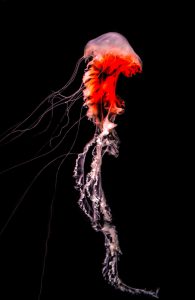
- This Jellyfish is just the size of a thumbnail but could have tentacles of up to three feet.
- Jellyfish digest their food quickly. It would be difficult to float if they had to carry around large amounts of food in themselves.
- The venom of a single box jellyfish is so dangerous to humans that it can kill about 60 jellyfishes. They kill more people each year than the sharks do and holds the tag of being one of the most venomous creatures of the sea.
- The box jellyfish is unique in their kind because the species have 24 eyes, four parallel brains, and 60 anal regions. Two of its eyes can see color. It is also one of the few animals on the planet that has a 360-degree view of its surroundings.
- Box jellyfish, unlike true Jellyfish, are more aggressive hunters, mainly because they have eyes. They are great swimmers too. A box of medleys can swim at speeds up to 4 mph, which is faster than most people are able to swim.
- Scientists have developed antivenom for box jellyfish stings. In Australia, ambulances, and hospitals keep the life-saving venom every time in stocks.
- Most Jellyfish have two basic life stages. In the first stage, they are called polyps, and they grow up by making buds, just like the plants. The polyp then buds off a young jellyfish called an ephyra. After few weeks, the ephyra becomes an adult jellyfish.
- Jellyfish have been responsible for temporarily shutting down a nuclear power plant in Japan after becoming stuck in its cooling system. The Japanese called these jellyfish Echizen kurage or, in English, Nomura’s Jellyfish.
- Jellyfish that stay near the sunlight at the surface of the water tend to be colorless. Whereas the jellyfishes that swim deeper in the ocean are often red, purple, green, yellow, and sometimes they may even have stripes.
- Jellyfishes that stay in sunlight on the surface of the waters appear to be colorless. Whereas Jellyfish that swim deeper are mostly red, purple, green, yellow, and may even have stripes.
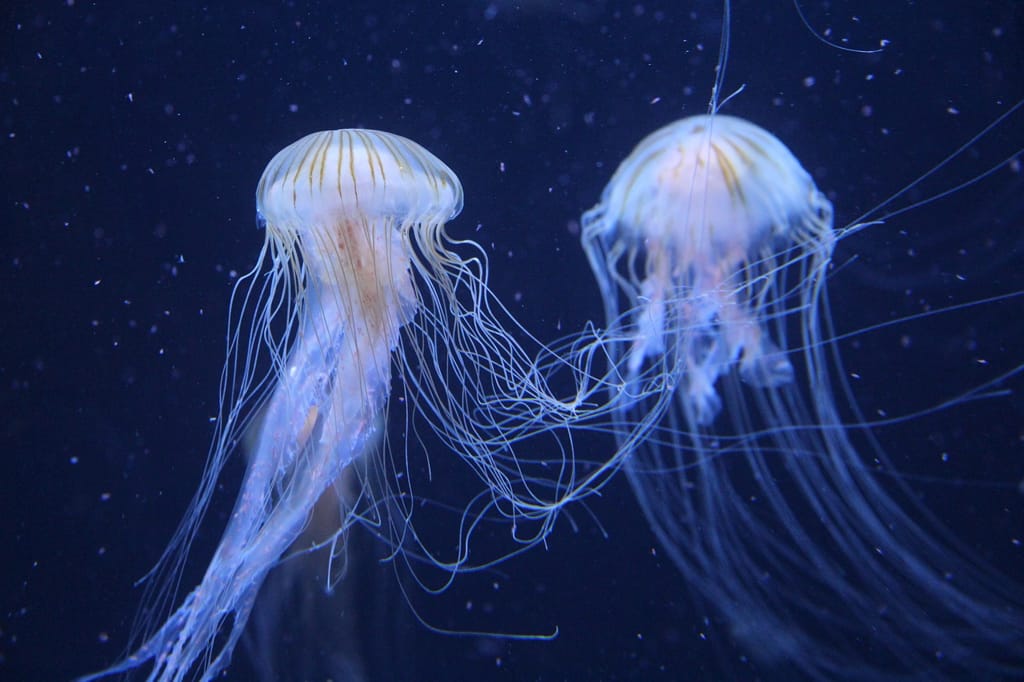
- Different Jellyfish have babies in different ways. Some jellyfish shoot eggs out of their mouth to be fertilized outside the body; others carry the eggs in their mouth until it develops enough on live on its own.
- A military robotic jellyfish has been created to go on search-and-rescue and survey missions. The silicone Robojelly uses hydrogen and oxygen for fuel as it swims, so its only thing they exhausts is heat and water. Its muscles are made from a shape-memory alloy, a metal invented by NASA that remembers its original shape.
- The uncoiling of the jellyfish’s small stingers is one of the fastest actions in nature. Their Stingers shoot out even faster than a gun’s bullet.
- On average, one person per year is killed in Australia by a box jellyfish. Box jellyfish may kill as many as 100 other people per year in other parts of the world, such as the Philippines, Indonesia, and Thailand.
- A box jellyfish sting is so dangerous that it can kill a person by stopping the heart in about two minutes.
- The Australian box jellyfish has eight eyes.


